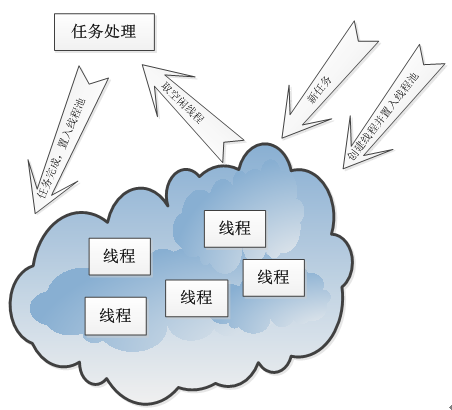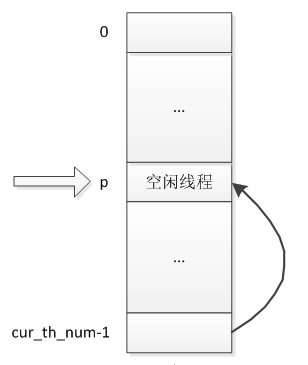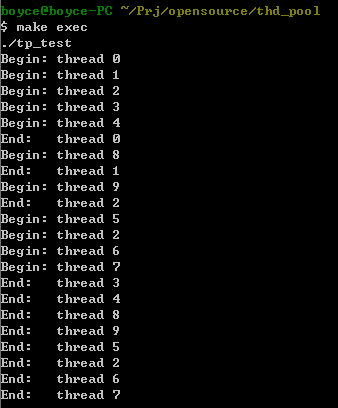Linux下设计一个简单的线程池
2011-08-03 16:51
621 查看
定义
什么是线程池?简单点说,线程池就是有一堆已经创建好了的线程,初始它们都处于空闲等待状态,当有新的任务需要处理的时候,就从这个池子里面取一个空闲等待的线程来处理该任务,当处理完成了就再次把该线程放回池中,以供后面的任务使用。当池子里的线程全都处理忙碌状态时,线程池中没有可用的空闲等待线程,此时,根据需要选择创建一个新的线程并置入池中,或者通知任务线程池忙,稍后再试。
为什么要用线程池?
我们说,线程的创建和销毁比之进程的创建和销毁是轻量级的,但是当我们的任务需要大量进行大量线程的创建和销毁操作时,这个消耗就会变成的相当大。比如,当你设计一个压力性能测试框架的时候,需要连续产生大量的并发操作,这个是时候,线程池就可以很好的帮上你的忙。线程池的好处就在于线程复用,一个任务处理完成后,当前线程可以直接处理下一个任务,而不是销毁后再创建,非常适用于连续产生大量并发任务的场合。
线程池工作原理
线程池中每一个线程的工作过程如下:
图 1: 线程的工作流程
线程池的任务就在于负责这些线程的创建,销毁和任务处理参数传递、唤醒和等待。
1. 创建若干线程,置入线程池
2. 任务达到时,从线程池取空闲线程
3. 取得了空闲线程,立即进行任务处理
4. 否则新建一个线程,并置入线程池,执行3
5. 如果创建失败或者线程池已满,根据设计策略选择返回错误或将任务置入处理队列,等待处理
6. 销毁线程池

图 2:线程池的工作原理
线程池设计
数据结构设计
任务设计
viewplain
typedef struct tp_work_desc_s TpWorkDesc;
typedef void (*process_job)(TpWorkDesc*job);
struct tp_work_desc_s {
void *ret; //call in, that is arguments
void *arg; //call out, that is return value
};
其中,TpWorkDesc是任务参数描述,arg是传递给任务的参数,ret则是任务处理完成后的返回值;
process_job函数是任务处理函数原型,每个任务处理函数都应该这样定义,然后将它作为参数传给线程池处理,线程池将会选择一个空闲线程通过调用该函数来进行任务处理;
线程设计
viewplain
typedef struct tp_thread_info_s TpThreadInfo;
struct tp_thread_info_s {
pthread_t thread_id; //thread id num
TPBOOL is_busy; //thread status:true-busy;flase-idle
pthread_cond_t thread_cond;
pthread_mutex_t thread_lock;
process_job proc_fun;
TpWorkDesc* th_job;
TpThreadPool* tp_pool;
};
TpThreadInfo是对一个线程的描述。
thread_id是该线程的ID;
is_busy用于标识该线程是否正处理忙碌状态;
thread_cond用于任务处理时的唤醒和等待;
thread_lock,用于任务加锁(此处保留);
proc_fun是当前任务的回调函数地址;
th_job是任务的参数信息;
tp_pool是所在线程池的指针;
线程池设计
viewplain
typedef struct tp_thread_pool_s TpThreadPool;
struct tp_thread_pool_s {
unsigned min_th_num; //min thread number in the pool
unsigned cur_th_num; //current thread number in the pool
unsigned max_th_num; //max thread number in the pool
pthread_mutex_t tp_lock;
pthread_t manage_thread_id; //manage thread id num
TpThreadInfo* thread_info;
Queue idle_q;
TPBOOL stop_flag;
};
TpThreadPool是对线程池的描述。
min_th_num是线程池中至少存在的线程数,线程池初始化的过程中会创建min_th_num数量的线程;
cur_th_num是线程池当前存在的线程数量;
max_th_num则是线程池最多可以存在的线程数量;
tp_lock用于线程池管理时的互斥;
manage_thread_id是线程池的管理线程ID;
thread_info则是指向线程池数据,这里使用一个数组来存储线程池中线程的信息,该数组的大小为max_th_num;
idle_q是存储线程池空闲线程指针的队列,用于从线程池快速取得空闲线程;
stop_flag用于线程池的销毁,当stop_flag为FALSE时,表明当前线程池需要销毁,所有忙碌线程在处理完当前任务后会退出;
算法设计
线程池的创建和初始化
线程创建
创建伊始,线程池线程容量大小上限为max_th_num,初始容量为min_th_num;view
plain
TpThreadPool *tp_create(unsigned min_num, unsigned max_num) {
TpThreadPool *pTp;
pTp = (TpThreadPool*) malloc(sizeof(TpThreadPool));
memset(pTp, 0, sizeof(TpThreadPool));
//init member var
pTp->min_th_num = min_num;
pTp->cur_th_num = min_num;
pTp->max_th_num = max_num;
pthread_mutex_init(&pTp->tp_lock, NULL);
//malloc mem for num thread info struct
if (NULL != pTp->thread_info)
free(pTp->thread_info);
pTp->thread_info = (TpThreadInfo*) malloc(sizeof(TpThreadInfo) * pTp->max_th_num);
memset(pTp->thread_info, 0, sizeof(TpThreadInfo) * pTp->max_th_num);
return pTp;
}
线程初始化
viewplain
TPBOOL tp_init(TpThreadPool *pTp) {
int i;
int err;
TpThreadInfo *pThi;
initQueue(&pTp->idle_q);
pTp->stop_flag = FALSE;
//create work thread and init work thread info
for (i = 0; i < pTp->min_th_num; i++) {
pThi = pTp->thread_info +i;
pThi->tp_pool = pTp;
pThi->is_busy = FALSE;
pthread_cond_init(&pThi->thread_cond, NULL);
pthread_mutex_init(&pThi->thread_lock, NULL);
pThi->proc_fun = def_proc_fun;
pThi->th_job = NULL;
enQueue(&pTp->idle_q, pThi);
err = pthread_create(&pThi->thread_id, NULL, tp_work_thread, pThi);
if (0 != err) {
perror("tp_init: create work thread failed.");
clearQueue(&pTp->idle_q);
return FALSE;
}
}
//create manage thread
err = pthread_create(&pTp->manage_thread_id, NULL, tp_manage_thread, pTp);
if (0 != err) {
clearQueue(&pTp->idle_q);
printf("tp_init: creat manage thread failed\n");
return FALSE;
}
return TRUE;
}
初始线程池中线程数量为min_th_num,对这些线程一一进行初始化;
将这些初始化的空闲线程一一置入空闲队列;
创建管理线程,用于监控线程池的状态,并适当回收多余的线程资源;
线程池的关闭和销毁
viewplain
void tp_close(TpThreadPool *pTp, TPBOOL wait) {
unsigned i;
pTp->stop_flag = TRUE;
if (wait) {
for (i = 0; i < pTp->cur_th_num; i++) {
pthread_cond_signal(&pTp->thread_info[i].thread_cond);
}
for (i = 0; i < pTp->cur_th_num; i++) {
pthread_join(pTp->thread_info[i].thread_id, NULL);
pthread_mutex_destroy(&pTp->thread_info[i].thread_lock);
pthread_cond_destroy(&pTp->thread_info[i].thread_cond);
}
} else {
//close work thread
for (i = 0; i < pTp->cur_th_num; i++) {
kill((pid_t)pTp->thread_info[i].thread_id, SIGKILL);
pthread_mutex_destroy(&pTp->thread_info[i].thread_lock);
pthread_cond_destroy(&pTp->thread_info[i].thread_cond);
}
}
//close manage thread
kill((pid_t)pTp->manage_thread_id, SIGKILL);
pthread_mutex_destroy(&pTp->tp_lock);
//free thread struct
free(pTp->thread_info);
pTp->thread_info = NULL;
}
线程池关闭的过程中,可以选择是否对正在处理的任务进行等待,如果是,则会唤醒所有任务,然后等待所有任务执行完成,然后返回;如果不是,则将立即杀死所有线程,然后返回,注意:这可能会导致任务的处理中断而产生错误!
任务处理
viewplain
TPBOOL tp_process_job(TpThreadPool *pTp, process_job proc_fun, TpWorkDesc *job) {
TpThreadInfo *pThi ;
//fill pTp->thread_info's relative work key
pthread_mutex_lock(&pTp->tp_lock);
pThi = (TpThreadInfo *) deQueue(&pTp->idle_q);
pthread_mutex_unlock(&pTp->tp_lock);
if(pThi){
pThi->is_busy =TRUE;
pThi->proc_fun = proc_fun;
pThi->th_job = job;
pthread_cond_signal(&pThi->thread_cond);
DEBUG("Fetch a thread from pool.\n");
return TRUE;
}
//if all current thread are busy, new thread is created here
pthread_mutex_lock(&pTp->tp_lock);
pThi = tp_add_thread(pTp);
pthread_mutex_unlock(&pTp->tp_lock);
if(!pThi){
DEBUG("The thread pool is full, no more thread available.\n");
return FALSE;
}
DEBUG("No more idle thread, created a new one.\n");
pThi->proc_fun = proc_fun;
pThi->th_job = job;
//send cond to work thread
pthread_cond_signal(&pThi->thread_cond);
return TRUE;
}
当一个新任务到达是,线程池首先会检查是否有可用的空闲线程,如果是,则采用才空闲线程进行任务处理并返回TRUE,如果不是,则尝试新建一个线程,并使用该线程对任务进行处理,如果失败则返回FALSE,说明线程池忙碌或者出错。
view
plain
static void *tp_work_thread(void *arg) {
pthread_t curid;//current thread id
TpThreadInfo *pTinfo = (TpThreadInfo *) arg;
//wait cond for processing real job.
while (!(pTinfo->tp_pool->stop_flag)) {
pthread_mutex_lock(&pTinfo->thread_lock);
pthread_cond_wait(&pTinfo->thread_cond, &pTinfo->thread_lock);
pthread_mutex_unlock(&pTinfo->thread_lock);
//process
pTinfo->proc_fun(pTinfo->th_job);
//thread state be set idle after work
//pthread_mutex_lock(&pTinfo->thread_lock);
pTinfo->is_busy = FALSE;
enQueue(&pTinfo->tp_pool->idle_q, pTinfo);
//pthread_mutex_unlock(&pTinfo->thread_lock);
DEBUG("Job done, I am idle now.\n");
}
}
上面这个函数是任务处理函数,该函数将始终处理等待唤醒状态,直到新任务到达或者线程销毁时被唤醒,然后调用任务处理回调函数对任务进行处理;当任务处理完成时,则将自己置入空闲队列中,以供下一个任务处理。
view
plain
TpThreadInfo *tp_add_thread(TpThreadPool *pTp) {
int err;
TpThreadInfo *new_thread;
if (pTp->max_th_num <= pTp->cur_th_num)
return NULL;
//malloc new thread info struct
new_thread = pTp->thread_info + pTp->cur_th_num;
new_thread->tp_pool = pTp;
//init new thread's cond & mutex
pthread_cond_init(&new_thread->thread_cond, NULL);
pthread_mutex_init(&new_thread->thread_lock, NULL);
//init status is busy, only new process job will call this function
new_thread->is_busy = TRUE;
err = pthread_create(&new_thread->thread_id, NULL, tp_work_thread, new_thread);
if (0 != err) {
free(new_thread);
return NULL;
}
//add current thread number in the pool.
pTp->cur_th_num++;
return new_thread;
}
上面这个函数用于向线程池中添加新的线程,该函数将会在当线程池没有空闲线程可用时被调用。
函数将会新建一个线程,并设置自己的状态为busy(立即就要被用于执行任务)。
线程池管理
线程池的管理主要是监控线程池的整体忙碌状态,当线程池大部分线程处于空闲状态时,管理线程将适当的销毁一定数量的空闲线程,以便减少线程池对系统资源的消耗。这里设计认为,当空闲线程的数量超过线程池线程数量的1/2时,线程池总体处理空闲状态,可以适当销毁部分线程池的线程,以减少线程池对系统资源的开销。
线程池状态计算
这里的BUSY_THRESHOLD的值是0.5,也即是当空闲线程数量超过一半时,返回0,说明线程池整体状态为闲,否则返回1,说明为忙。view
plain
int tp_get_tp_status(TpThreadPool *pTp) {
float busy_num = 0.0;
int i;
//get busy thread number
busy_num = pTp->cur_th_num - pTp->idle_q.count;
DEBUG("Current thread pool status, current num: %u, busy num: %u, idle num: %u\n", pTp->cur_th_num, (unsigned)busy_num, pTp->idle_q.count);
//0.2? or other num?
if (busy_num / (pTp->cur_th_num) < BUSY_THRESHOLD)
return 0;//idle status
else
return 1;//busy or normal status
}
线程的销毁算法
1. 从空闲队列中dequeue一个空闲线程指针,该指针指向线程信息数组的某项,例如这里是p;
2. 销毁该线程
3. 把线程信息数组的最后一项拷贝至位置p
4. 线程池数量减少一,即cur_th_num--

图 3:线程销毁
view
plain
TPBOOL tp_delete_thread(TpThreadPool *pTp) {
unsigned idx;
TpThreadInfo *pThi;
TpThreadInfo tT;
//current thread num can't < min thread num
if (pTp->cur_th_num <= pTp->min_th_num)
return FALSE;
//pthread_mutex_lock(&pTp->tp_lock);
pThi = deQueue(&pTp->idle_q);
//pthread_mutex_unlock(&pTp->tp_lock);
if(!pThi)
return FALSE;
//after deleting idle thread, current thread num -1
pTp->cur_th_num--;
memcpy(&tT, pThi, sizeof(TpThreadInfo));
memcpy(pThi, pTp->thread_info + pTp->cur_th_num, sizeof(TpThreadInfo));
//kill the idle thread and free info struct
kill((pid_t)tT.thread_id, SIGKILL);
pthread_mutex_destroy(&tT.thread_lock);
pthread_cond_destroy(&tT.thread_cond);
return TRUE;
}
线程池监控
线程池通过一个管理线程来进行监控,管理线程将会每隔一段时间对线程池的状态进行计算,根据线程池的状态适当的销毁部分线程,减少对系统资源的消耗。
view
plain
static void *tp_manage_thread(void *arg) {
TpThreadPool *pTp = (TpThreadPool*) arg;//main thread pool struct instance
//1?
sleep(MANAGE_INTERVAL);
do {
if (tp_get_tp_status(pTp) == 0) {
do {
if (!tp_delete_thread(pTp))
break;
} while (TRUE);
}//end for if
//1?
sleep(MANAGE_INTERVAL);
} while (!pTp->stop_flag);
return NULL;
}
程序测试
至此,我们的设计需要使用一个测试程序来进行验证。于是,我们写下这样一段代码。
view
plain
#include <stdio.h>
#include <unistd.h>
#include "thread_pool.h"
#define THD_NUM 10
void proc_fun(TpWorkDesc *job){
int i;
int idx=*(int *)job->arg;
printf("Begin: thread %d\n", idx);
sleep(3);
printf("End: thread %d\n", idx);
}
int main(int argc, char **argv){
TpThreadPool *pTp= tp_create(5,10);
TpWorkDesc pWd[THD_NUM];
int i, *idx;
tp_init(pTp);
for(i=0; i < THD_NUM; i++){
idx=(int *) malloc(sizeof(int));
*idx=i;
pWd[i].arg=idx;
tp_process_job(pTp, proc_fun, pWd+i);
usleep(400000);
}
//sleep(1);
tp_close(pTp, TRUE);
free(pTp);
printf("All jobs done!\n");
return 0;
}
执行结果:

源码下载
地址:https://sourceforge.net/projects/thd-pool-linux/备注
该线程池设计比较简单,尚存在不少BUG,欢迎各位提出改进意见。
转自:http://blog.csdn.net/hinyunsin/article/details/6650879
相关文章推荐
- Linux下设计一个简单的线程池
- Linux下设计一个简单的线程池
- Linux下设计一个简单的线程池
- 线程池的概念及Linux 怎么设计一个简单的线程池
- 线程池的概念及Linux 怎么设计一个简单的线程池
- Linux下设计一个简单的线程池
- Linux下设计一个简单的线程池
- Linux下设计一个简单的线程池
- Linux下设计一个简单的线程池
- Linux多线程实践(9) --简单线程池的设计与实现
- Linux C++ 一个线程池的简单实现(附代码)
- 一个简单的linux线程池
- Linux脚本设计练习2——一个游戏菜单的简单实现
- 一个简单的linux线程池(转-wangchenxicool)
- 一个简单的linux线程池
- 主题:一个简单的linux线程池
- 学习LSM(Linux security module)之四:一个基于LSM的简单沙箱的设计与实现
- 为LINUX 设计一个简单的二级文件系统。
- 【原创】TCP Socket 简单练习 --- 线程池实现并发服务器 分类: Linux --- 应用程序设计 2014-12-25 13:59 50人阅读 评论(0) 收藏
- linux下用c语言实现一个简单的线程池
